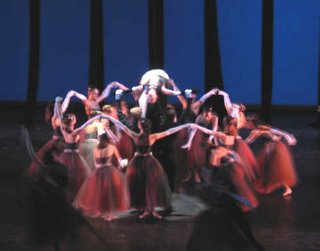The Mariinsky Ballet Dances Balanchine
As a part of the XIV International Arts Festival “Stars of the White Nights” currently underway in St. Petersburg, the Mariinsky Ballet Company paid tribute to its most famous alumnus – one of the greatest choreographers of the 20th century and a St. Petersburg native – George Balanchine. For decades Balanchine’s name had been blacklisted in Russia. Only in the late 1980s did the Mariinsky Ballet begin exploring his choreographic heritage and learn to dance à la Balanchine, mastering his classical steps and distinct movement vocabulary. The all-Balanchine program presented on May 23 at the Mariinsky Theater included three ballets from three different creative periods of the choreographer: The Serenade (1935), La Valse (1951), and Ballet Imperial (1941).
Serenade is a music-inspired ballet set to Tchaikovsky’s Serenade in C Major for String Orchestra. This is the first ballet Balanchine created in America and still one of his most popular and widely performed works. Pure dance without a storyline, it allows the audience to create its own interpretation of what happens on stage. Watching the simple, very classical choreography, I felt like I was watching a presentation of young ballerinas demonstrating their dancing talents. The opening reveals seventeen ballerinas in light blue long tulle frocks standing against a blue background with dimmed light creating the atmosphere of mystery and tranquility. This is one of the most beautiful scenes choreographed by Balanchine for the corps de ballet. The performances of soloists Xenia Ostreikovskay, Yekaterina Osmolkina, and Sofia Gumerova were most impressive. The male soloists Denis Firsov and Sergei Popov were technically impeccable at turning, supporting, lifting, and carrying ballerinas about the stage. But the real star was the Mariinsky’s corps de ballet, demonstrating unity of movements, expressiveness, artistry, and absolutely flawless technique. Balanchine’s La Valse is more than just a dance: it’s a spectacle, it’s a ballroom drama. The first part of the ballet is set to Ravel’s Valses nobles et sentimentales (which were originally designed to become the ballet Adelaïde) with the first waltz played as an overture. Each of the following waltzes is danced by a formally dressed couple or a group of soloists. The ballerinas are wearing long romantic red and black skirts with silver tulle, while their partners were all in black (costumes designed by frequent Balanchine collaborator Barbara Karinska). A couple (Daria Pavlenko, Ilya Kuznetsov) finds happiness with each other in a waltz until an outsider (a figure invoking Death) intrudes, charming, seducing, misguiding the girl into a final waltz that costs her her life. The corps de ballet was superb in this magnificent dramatic spectacle. Daria Pavlenko, one of the company’s truly outstanding principals, danced with a gentle, ethereal grace. (She can be seen in Washington dancing Giselle at the Kennedy Center on June 16.)
Balanchine’s La Valse is more than just a dance: it’s a spectacle, it’s a ballroom drama. The first part of the ballet is set to Ravel’s Valses nobles et sentimentales (which were originally designed to become the ballet Adelaïde) with the first waltz played as an overture. Each of the following waltzes is danced by a formally dressed couple or a group of soloists. The ballerinas are wearing long romantic red and black skirts with silver tulle, while their partners were all in black (costumes designed by frequent Balanchine collaborator Barbara Karinska). A couple (Daria Pavlenko, Ilya Kuznetsov) finds happiness with each other in a waltz until an outsider (a figure invoking Death) intrudes, charming, seducing, misguiding the girl into a final waltz that costs her her life. The corps de ballet was superb in this magnificent dramatic spectacle. Daria Pavlenko, one of the company’s truly outstanding principals, danced with a gentle, ethereal grace. (She can be seen in Washington dancing Giselle at the Kennedy Center on June 16.) Set to Tchaikovsky’s second piano concerto and coming after the darkness of La Valse, Ballet Imperial is a relief and lifts the spirits. This homage to imperial St. Petersburg and its Grand Imperial Ballet presents Balanchine’s choreography at its best. The company’s star, Uliana Lopatkina, danced the leading role of the Queen, while Irina Golub was the Crown Princess. Watching Lopatkina dance effortlessly, it was hard to believe that she was dealing with the most challenging and technically demanding choreography in Balanchine’s repertory. The ensemble performed brilliantly, proving time and again what the Mariinsky Ballet is rightly famous for – its Grand Imperial Corps de Ballet.
Set to Tchaikovsky’s second piano concerto and coming after the darkness of La Valse, Ballet Imperial is a relief and lifts the spirits. This homage to imperial St. Petersburg and its Grand Imperial Ballet presents Balanchine’s choreography at its best. The company’s star, Uliana Lopatkina, danced the leading role of the Queen, while Irina Golub was the Crown Princess. Watching Lopatkina dance effortlessly, it was hard to believe that she was dealing with the most challenging and technically demanding choreography in Balanchine’s repertory. The ensemble performed brilliantly, proving time and again what the Mariinsky Ballet is rightly famous for – its Grand Imperial Corps de Ballet.
This month the Kirov (Mariinsky) Ballet is coming to Washington, D.C., where it will present a program titled “William Forsythe Masterworks” (June 13 – 15) and the ever popular Giselle (June 16 - 18) in the Kennedy Center Opera House.




















































No comments:
Post a Comment